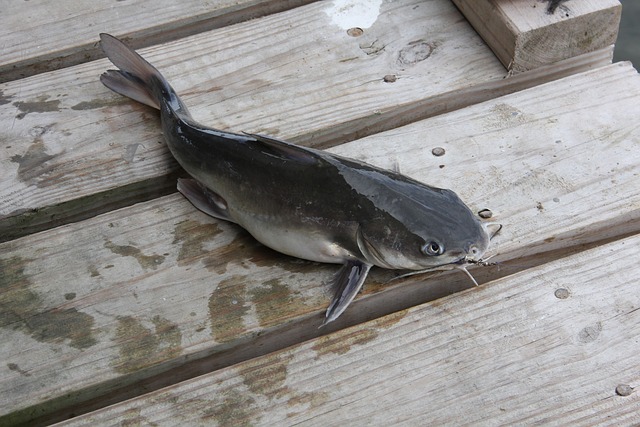Have you ever gazed out onto a calm lake or river and noticed catfish breaking the surface of the water? It’s a sight that has left many anglers and nature enthusiasts pondering the reasons behind this intriguing behavior. As someone who is passionate about catfish and their fascinating habits, I couldn’t help but dive deeper into the mystery of why catfish come to the surface.
Catfish come to the surface primarily to access oxygen. They have specialized air-breathing organs that allow them to extract oxygen directly from the air. When dissolved oxygen levels in the water are low or depleted, catfish instinctively rise to the surface to gulp air, replenishing their oxygen supply.
Additionally, they may come to the surface for feeding opportunities, especially during insect hatches or when surface-dwelling prey is present. Breeding behaviors and environmental factors like water quality can also influence their surface activity.
But this isn’t the whole picture. Keep reading!
Understanding the Catfish Species
Before I delve into the specific reasons why catfish come to the surface, let’s take a closer look at these incredible creatures and the different species that inhabit our waters. Understanding their general characteristics will help us appreciate their behavior better.
Catfish are a diverse group of fish found in freshwater environments across the globe. From the majestic channel catfish to the monstrous flathead catfish, there are numerous species that capture the attention of anglers and nature enthusiasts alike. Let’s briefly explore some of the key features of catfish species:
1. Physical Adaptations
-
- Whisker-like Barbels: Catfish are equipped with barbels, which are fleshy, whisker-like appendages located near their mouths. These barbels help them navigate and locate food, acting as sensory organs.
- Scaleless Bodies: Unlike many other fish species, catfish possess smooth, scaleless skin, making them unique in appearance and texture.
- Spines and Fin Arrangement: Catfish have sharp spines, particularly on their pectoral and dorsal fins, serving as defense mechanisms against predators.
2. Feeding Habits
-
- Bottom Dwellers: Catfish are often associated with being bottom dwellers, scouring the riverbed or lake floor in search of food.
- Omnivorous Diet: Catfish are opportunistic feeders, consuming a wide variety of food sources. Their diet can include anything from insects and small fish to plant matter and even carrion.
3. Habitat Preferences
-
- Varying Preferences: Different catfish species exhibit preferences for specific habitats, ranging from fast-flowing rivers to calm lakes or reservoirs.
- Shallow and Deep Water: Some species, like channel catfish, are more commonly found in shallow waters near the shore, while others, such as the blue catfish, are known to inhabit deeper sections of rivers and lakes.
Each catfish species has its own unique characteristics and behavior patterns. By understanding these general traits, you can begin to unravel the reasons behind their surface visits. So, let’s dive deeper and explore the factors that influence catfish behavior and bring them to the water’s surface.
Oxygen Levels and Temperature Variations
When it comes to the behavior of catfish, oxygen levels and temperature play a crucial role. Let’s explore how these factors influence catfish and why they may come to the surface.
1. The Role of Dissolved Oxygen:
-
- Oxygen is vital for fish survival, as they require it for respiration.
- In aquatic environments, oxygen is dissolved in the water, allowing fish to extract it through their gills.
- Adequate oxygen levels support normal fish behavior and metabolism.
2. Surface Access to Oxygen:
-
- Under certain circumstances, the oxygen levels in the water may become limited, especially in warm water or densely populated fish habitats.
- Catfish have a unique adaptation known as “air-breathing organs” or labyrinth organs, which allow them to extract oxygen directly from the air.
- When dissolved oxygen levels decrease, catfish may come to the surface to gulp air, replenishing their oxygen supply.
3. Seasonal Variations:
-
- Oxygen levels in water can fluctuate throughout the year, particularly during different seasons.
- In warmer seasons, water temperatures rise, which can lead to decreased oxygen solubility.
- During periods of low oxygen, such as in stagnant waters or hot summer months, catfish may seek oxygen-rich surface waters to meet their respiratory needs.
Understanding the correlation between oxygen levels, temperature, and catfish behavior provides insight into why they come to the surface. By surfacing to obtain oxygen directly from the air, catfish can ensure their survival even when the dissolved oxygen levels in the water are insufficient.
In the next section, I’ll explore how feeding opportunities influence the surface behavior of catfish, shedding light on their food-seeking strategies.
Feeding Opportunities
Catfish are opportunistic feeders, always on the lookout for a tasty meal. Their surface visits can often be attributed to the presence of enticing feeding opportunities. Let’s delve into the factors that contribute to catfish coming to the surface to feed.
1. Aquatic Insects and Prey:
-
- Many bodies of water, such as lakes and rivers, are teeming with a variety of aquatic insects.
- Insects like mayflies, caddisflies, and water beetles often hatch or emerge near the water’s surface.
- These insect hatches create a feeding frenzy for catfish, as they take advantage of the abundance of prey near the surface.
2. Insect Hatches:
-
- Catfish have a keen sense of smell and are attracted to the scent and movement of insects on the water.
- When insects hatch and gather on the surface, catfish will actively pursue them, often breaking the surface to snatch their prey.
3. Surface-Dwelling Prey:
-
- Smaller fish, frogs, crayfish, and other creatures may also be found near the water’s surface.
- These surface-dwelling prey items provide easy targets for catfish, prompting them to venture to the surface in search of a quick meal.
Catfish have an excellent ability to detect and locate food using their sensory organs, particularly their barbels and taste buds. Their opportunistic nature leads them to exploit feeding opportunities whenever they arise, including those found near the water’s surface. So, if you spot catfish breaking the surface, chances are they’re on the lookout for a delectable snack.
Reproduction and Spawning Behavior
Catfish, like many other fish species, exhibit specific behaviors during their reproductive season. These breeding activities can influence catfish behavior, including their surface visits. Let’s explore the fascinating world of catfish reproduction and spawning behavior.
1. Spawning Season:
-
- Catfish have specific periods when they engage in breeding activities, commonly referred to as the spawning season.
- During this time, catfish become more active and display distinct behaviors related to reproduction.
2. Nest Preparation:
-
- Male catfish play a crucial role in nest preparation.
- They search for suitable locations, often near the shoreline or in shallow areas with cover or structure, where they construct nests.
- The nest-building process involves clearing debris, creating depressions, and guarding the future spawning site.
3. Courtship Displays:
-
- Catfish engage in elaborate courtship rituals to attract mates.
- These displays can include surface movements, fin flaring, and vigorous rubbing against objects.
- The male catfish may even create vibrations or sounds to signal their readiness to breed.
4. Surface Spawning:
-
- Some catfish species, such as the channel catfish, may engage in surface spawning.
- During this process, the female releases eggs while the male fertilizes them.
- This behavior can result in increased surface activity as catfish gather and interact in preparation for spawning.
The breeding season and associated spawning behaviors can provide a compelling reason for catfish to come to the surface. The surface activity observed during this time is often driven by the instinctual need to find suitable spawning locations, attract mates, and ensure successful reproduction.
Next, I’ll explore the influence of environmental factors and water quality on catfish behavior, shedding light on how these conditions can drive them to the surface.
Environmental Factors and Water Quality
Environmental factors and water quality play a significant role in the behavior of catfish. Let’s uncover how these factors can influence catfish and prompt them to come to the surface.
1. Oxygen Depletion
-
- In certain situations, water bodies may experience low oxygen levels, leading to hypoxia or even anoxia.
- Oxygen depletion can occur due to factors like excessive algae growth, decomposition of organic matter, or high water temperatures.
- When oxygen levels decrease significantly in the water, catfish may come to the surface to access atmospheric oxygen through their labyrinth organs.
2. Pollution and Contaminants
-
- Poor water quality resulting from pollution and contaminants can adversely affect catfish.
- Chemical pollutants, industrial runoff, and excessive nutrients can disrupt the delicate balance of aquatic ecosystems.
- Catfish may exhibit surface behavior as a response to compromised water quality, seeking better oxygenation or attempting to escape unfavorable conditions.
3. Algal Blooms
-
- Excessive growth of algae, often referred to as algal blooms, can negatively impact water quality.
- Algal blooms can deplete dissolved oxygen levels, particularly during the decomposition process.
- Catfish, sensitive to oxygen fluctuations, may come to the surface to access oxygen-rich areas and alleviate the effects of low oxygen caused by algal blooms.
It is important to note that catfish are resilient and can adapt to a range of environmental conditions. However, when faced with unfavorable circumstances such as oxygen depletion or poor water quality, they may exhibit surface behavior as a survival mechanism.
Curiosity and Exploration
While specific factors like oxygen levels, feeding opportunities, and reproductive behaviors play significant roles in catfish coming to the surface, it’s also essential to consider the natural curiosity and exploratory nature of these fascinating fish.
1. Natural Curiosity:
-
- Catfish, like many other aquatic creatures, possess a natural curiosity that drives them to explore their surroundings.
- They may venture to different areas of their habitat, including the water’s surface, to investigate new sights, scents, or potential food sources.
2. Nocturnal Activity:
-
- Catfish are primarily nocturnal creatures, meaning they are more active during the nighttime.
- During their nocturnal forays, catfish may exhibit increased surface activity as they navigate their environment in search of prey or mates.
3. Sensory Stimulation:
-
- Catfish have well-developed sensory organs, particularly their barbels and taste buds, which allow them to sense and locate food.
- The surface of the water offers a unique sensory experience, providing catfish with new scents, vibrations, and potential food sources that may pique their curiosity.
While not every surface visit can be attributed to curiosity alone, it’s worth considering the inherent inquisitiveness of catfish when observing their behavior. Their ventures to the surface may be driven by a combination of factors, including the desire to explore, investigate new stimuli, and satisfy their natural curiosity.
What Size Hook for Flathead Catfish? Expert Tips on Hook Selection
Conclusion
In conclusion, the behavior of why do catfish come to the surface is influenced by a variety of factors. They may surface to access oxygen when dissolved levels are low, seek feeding opportunities like insect hatches or surface-dwelling prey, exhibit breeding behaviors near the shoreline, respond to environmental factors such as oxygen depletion or poor water quality, and showcase their natural curiosity and exploration. These factors combined contribute to the intriguing behavior of catfish breaking the surface, highlighting their adaptability and survival strategies in their aquatic habitats.
So, the next time you spot a catfish breaking the surface of the water, take a moment to appreciate the complex interplay of factors that contribute to their behavior. The underwater world of catfish holds countless wonders, waiting to be discovered and appreciated.
Keep exploring, observing, and enjoying the beauty of these remarkable creatures, and feel free to share your own experiences and observations of catfish behavior. Together, let’s continue to unravel the secrets of why catfish come to the surface.
Related: How Long Can A Bass Live Out Of Water? Bass Survival Unveiled








